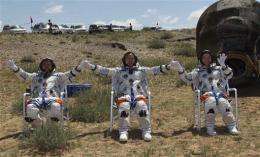Chinese astronauts parachute land after mission

(AP) — China's first female astronaut and two other crew members emerged smiling from a capsule that returned safely to Earth Friday from a 13-day mission to an orbiting module that is a prototype for a future space station.
The Shenzhou 9 parachuted to a landing on the grasslands of the country's sprawling Inner Mongolia region at about 10 a.m. (0200 GMT). China declared the first manned mission to the Tiangong 1 module a major stride ahead for the country's ambitious space program.
About an hour later, mission commander and veteran astronaut Jing Haipeng, 45, emerged from the capsule, followed by crew mates Liu Wang, 43, and 33-year-old Liu Yang, China's first female astronaut.
The three, all experienced air force pilots, were lifted on to folding chairs and appeared in good health. They smiled, waved, chatted and saluted as state television ran live footage from the landing site.
"Tiangong 1, our home in space, was comfortable and pleasant. We're very proud of our nation," Liu Yang told national broadcaster CCTV.
Space program commander, Gen. Chang Wanchuan, declared the astronauts in good health and declared the mission "completely successful."
He was followed by Premier Wen Jiabao, who said the mission marked "absolutely important progress" for the space program.
The mission had included both remote control and piloted dockings with the module and extensive medical monitoring of the astronauts as part of preparations for manning a permanent space station.
China's next goals include another manned mission to the module originally scheduled for later this year but which may be delayed depending on an evaluation of the Shenzhou 9 mission and the condition of the Tiangong 1. China has been extremely cautious and methodical in its manned missions, with more than three years passing since the previous one, and all four have been relatively problem-free.
Tiangong 1 is due to be retired in a few years and replaced with a permanent space station around 2020 that will weigh about 60 tons, slightly smaller than NASA's Skylab of the 1970s and about one-sixth the size of the 16-nation International Space Station that China was barred from participating in, largely on objections from the United States. Possible future missions could include sending a rover to the moon, possibly followed by a manned lunar mission.
Launched June 16 from the Jiuquan center on the edge of the Gobi desert in northern China, Shenzhou 9 is the latest success for China's manned space program that launched its first astronaut, Yang Liwei, into space in 2003, making China just the third nation after Russia and the U.S. to achieve that feat. China would also be the third country after the United States and Russia to send independently maintained space stations into orbit.
Earlier in the week, a spokeswoman said China spent 20 billion yuan ($3.1 billion) on its space program between 1992 and 2005 — a rare admission for a program with close links to the secretive military. By the time the next Shenzhou mission is completed, Beijing will have spent an additional 19 billion yuan ($3 billion), the spokeswoman said.
Copyright 2012 The Associated Press. All rights reserved. This material may not be published, broadcast, rewritten or redistributed.





















